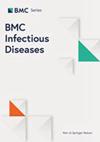摘要
导言:马里和几内亚接壤,都是淋巴丝虫病(LF)的流行国。然而,两国在消除这一疾病方面的进展却不尽相同。马里目前正处于淋巴丝虫病传播评估调查阶段(TAS),而几内亚则继续实施大规模药物管理(MDA)。由于这两个国家的人口密切相关,且存在病媒,理论上布古尼-延弗利拉评估单元(EU)有可能出现 LF。这项 XenoFil 研究结合了异种监测和医疗机构血清监测,被用作评估 LF 传播情况的监测工具。目的是在第三次LF传播评估调查(TAS3)之后,检测LF在布古尼-延弗利拉欧盟(Bougouni-Yanfolila EU)跨境地区的出现情况:方法:在布古尼-延弗利拉欧盟,我们开展了一项横断面研究,在村庄采集蚊子和6岁及以上(≥6岁)儿童的血液样本。2022 年 6 月、8 月和 2023 年 1 月,我们在两个生态不同的村庄进行了三次昆虫学研究。我们使用伊法卡拉 C 型帐篷诱捕器(IFAKARA)、雌蚊诱捕器和室内除虫菊喷洒诱捕器收集蚊子。在进行 qPCR 分析时,将同一种类的蚊子分成 20 组,使用 qPCR 进行分子分析。感染率/寄生虫感染率由 PoolScreen® 2 软件生成。经过培训的当地卫生工作者使用丝虫病试纸进行血清学调查:在两个研究村庄中,我们共收集到 4 732 只蚊子,其中 989 只属于冈比亚按蚊,3 743 只属于库蚊属,共形成了 264 个池子,库蚊属占 79.92%(211/264),按蚊属占 20.08%(53/264)。2022 年 6 月,只有一个库蚊池(0.53%)检测出阳性[95% CI:0.01-2.89]。疟蚊池中没有阳性疟蚊。2056 人中有 10 人的血液检测结果呈阳性[0.49% (10/2056)]。阳性者中,1 人属于 6-7 岁,2 人属于 8-17 岁,7 人属于 18 岁及以上。在阳性志愿者中,0.6%(6/996)来自 Yanfolila 边境卫生区。在一个评估单位进行的调查显示,XenoFil(昆虫学与血清学相结合)的平均费用为 5656244 非洲法郎(9070 美元),而 TAS 的平均费用为 6366450 非洲法郎(10209 美元):新的 XenoFil 方法被证明是在农村地区进行 LF 综合监测的一种简单、有效且相对便宜的方法。从 LF 综合监测的角度来看,需要将 XenoFil 推广到其他欧盟国家。Introduction: Mali and Guinea share a border and are both endemic for lymphatic filariasis (LF). However, their progress towards eliminating this disease varies. Mali is currently in the LF transmission assessment survey phase (TAS), while Guinea continues to implement mass drug administration (MDA). As the populations of these two countries are closely related, and vectors are present, the emergence of LF is theoretically possible in the Bougouni-Yanfolila evaluation unit (EU). This XenoFil study, which combines xenomonitoring and serosurveillance in health facilities, was used as a surveillance tool to assess LF transmission. The aim is to detect the emergence of LF in cross-border areas within the Bougouni-Yanfolila EU, after the third LF transmission assessment survey (TAS3).
Method: In the Bougouni-Yanfolila EU, we conducted a cross-sectional study to collect mosquitoes in the villages and blood samples from 6 years old and above (≥ 6 years old). In June, August 2022, and January 2023, we conducted three entomological studies in two ecologically distinct villages. The Ifakara type C tent trap (IFAKARA), the gravid trap, and indoor Pyrethrum spray catches were used to collect mosquitoes. For qPCR, mosquito of the same species was sorted into pools of twenty for molecular analysis using qPCR. The infection rate / the parasite prevalence was generated by the PoolScreen® 2 software. Trained local health workers performed serological surveys using filariasis test strips.
Results: In. the two study villages, we collected a total of 4,732 mosquitoes, of which 989 belonged to the species Anopheles gambiae s.l. and 3,743 to species of the genus Culex sp. A total of 264 pools were formed, with the genus Culex spp. accounted for 79.92% (211/264), while the genus Anopheles represented 20.08% (53/264). In June 2022, only one pool (0.53%) of Culex spp. tested positive [95% CI: 0.01-2.89]. Positive Anopheles pools were absent. The blood of ten of the 2056 individuals had positive results [0.49% (10/2056)]. Among the positives, one belonged to 6-7 years, two to that of 8-17 years, and seven to that of 18 years and older. Of the positive volunteers, 0.6% (6/996) were from Yanfolila's border health region. The average cost of XenoFil (entomology combined with serology) is 5,656,244 CFA francs (US$9070), and TAS has an average cost of 6,366,450 CFA francs (US$10209) in a survey conducted in one evaluation unit.
Conclusions: The new XenoFil approach proved to be an easy, effective, and relatively cheaper method for integrated LF surveillance in rural areas. From the perspective of integrated LF monitoring, XenoFil is needed for scaling up to other EU.

 求助内容:
求助内容: 应助结果提醒方式:
应助结果提醒方式:


